When choosing a bathroom vanity for your dressing area, the material selection is crucial, as bathrooms are consistently damp and exposed to chemical threats. Fortunately, you’ve arrived at Giving Tree Home—a specialized retailer of bathroom furniture. We not only offer high-quality products but are also dedicated to providing our customers with practical knowledge. This article serves as a comprehensive guide to selecting the right materials for your bathroom vanity, whether you're purchasing a new one or maintaining an existing unit. Let’s get started!
Key Areas of a Bathroom Vanity
When people shop for bathroom vanity, they often focus only on the cabinet and sink, which is a common misconception. A complete bathroom vanity actually consists of four parts: the cabinet, countertop, sink, and faucet. If you're planning to purchase an entire vanity unit, each of these four components needs careful consideration. Before diving into material choices, let's first understand the potential issues these key areas may face.
-
Cabinet
The cabinet forms the main structure of the vanity, responsible for storage and supporting weight. Although most cabinets use wood treated for water resistance, in a bathroom's high-humidity environment, wood can still absorb moisture, leading to mold growth, warping, and even structural instability.
-
Countertop
The countertop is the most exposed part of the vanity, often subject to damage. Low-end vanities might use wooden countertops, and if the waterproof coating is compromised, moisture can seep in, affecting both appearance and structural integrity. Even non-wood countertops are susceptible to scratches, wear, and chemical damage due to frequent contact with water and cleaning products.
-
Sink
The sink is where most daily bathroom activities take place. Sinks can be integrated with the countertop or installed separately. Common issues here include chemical corrosion, leaks, and blockages. Lower-quality sink materials may struggle to resist damage from cosmetics and cleaning agents.
-
Faucet
The faucet and its surrounding area are prone to limescale buildup, which can affect water flow and cause wear on the faucet’s seals, leading to leaks. Over time, metal faucets can corrode or rust, reducing their lifespan, especially when exposed to water and cleaning chemicals.
Recommended Materials for Bathroom Vanity Cabinets
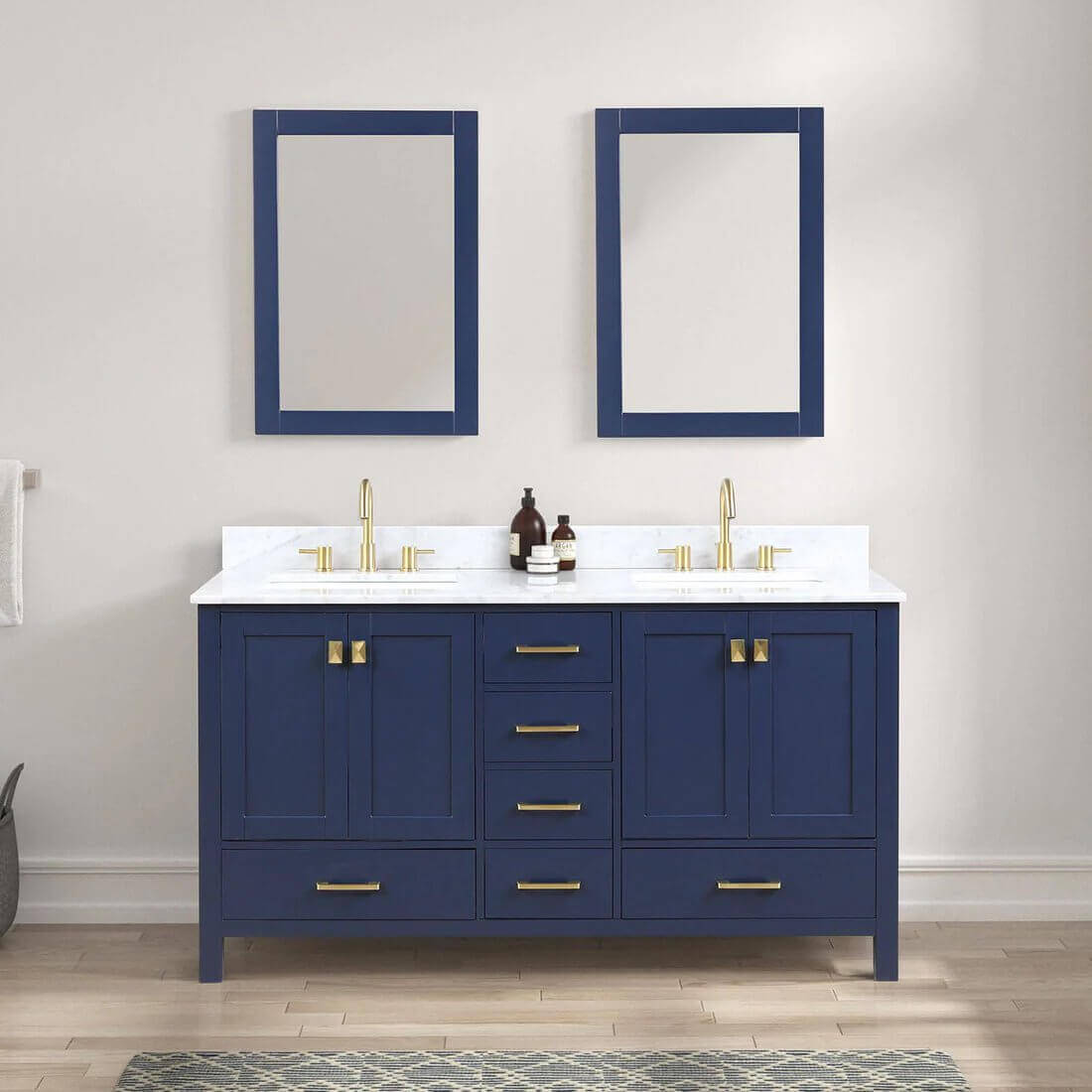
Solid Wood
Solid wood is widely recognized as a premium material for bathroom vanity cabinets, usually made from natural wood that has undergone minimal processing and is then coated with waterproof and anti-corrosion agents. Common types of solid wood include oak, walnut, cherry, and maple. These materials not only offer unique wood grains and colors but also boast excellent durability and strength. However, the high quality of solid wood comes at a higher cost, often several times more expensive than composite materials.
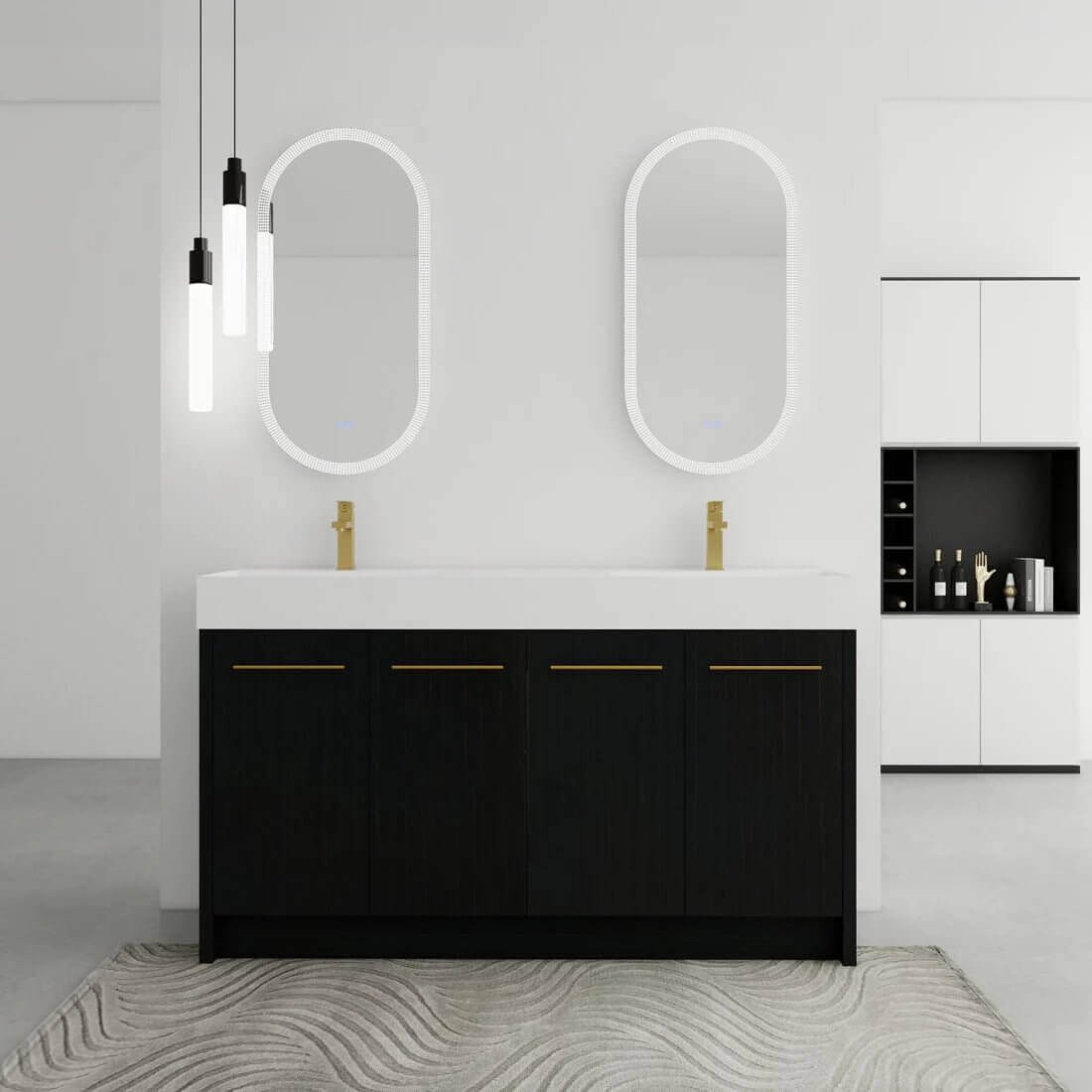
Plywood
Plywood is one of the most widely used materials for bathroom vanities today. It is made by bonding multiple layers of wood veneer in a cross-grain pattern, held together with adhesive. The advantage of this material lies in its cost and quality, which positions it between solid wood and MDF, making it highly cost-effective. However, since plywood is bonded together, some low-quality products may experience a decrease in adhesive strength in humid environments, affecting the cabinet’s durability.
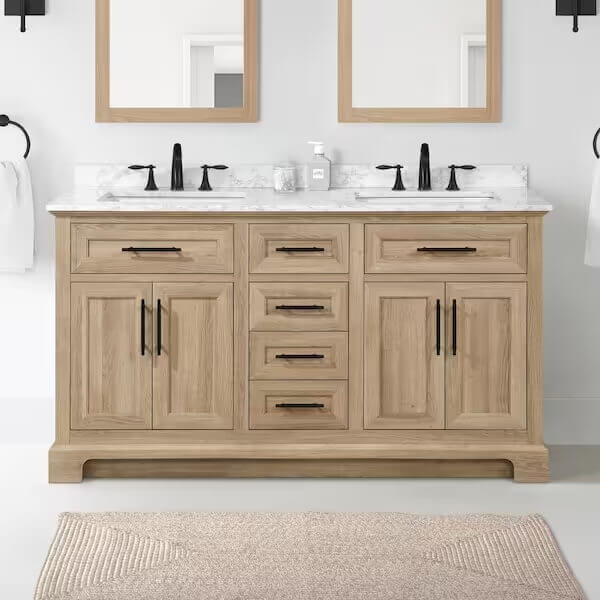
MDF
MDF, or Medium-Density Fiberboard, is a composite material made from wood fibers and adhesives processed under high temperature and pressure. The biggest advantage of MDF is its low cost, making it possibly the cheapest among all reliable bathroom vanity materials. Additionally, MDF is easy to work with, allowing for a greater variety of vanity styles. However, MDF is more prone to moisture absorption and scratches, so it requires extra care during use and maintenance. Despite this, its performance is still superior to that of particleboard.
Recommended Materials for Bathroom Vanity Countertops and Sinks
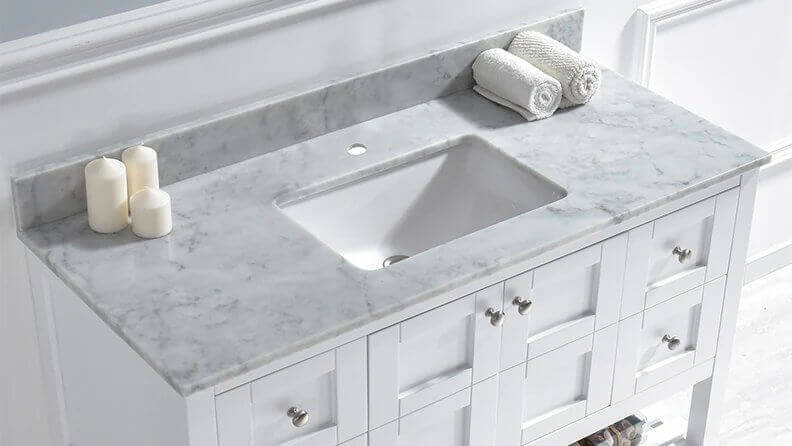
Marble
Marble is the material of choice for high-end residential and commercial bathroom vanity countertops. Its natural texture and luster give marble a noble, elegant appearance. Each piece of marble has unique patterns and colors, making every countertop uniquely beautiful. However, marble also has its drawbacks: it is expensive, and its surface easily absorbs liquids, making it prone to staining and seepage. Therefore, regular sealing and cleaning are necessary to maintain its aesthetic appeal and functionality.
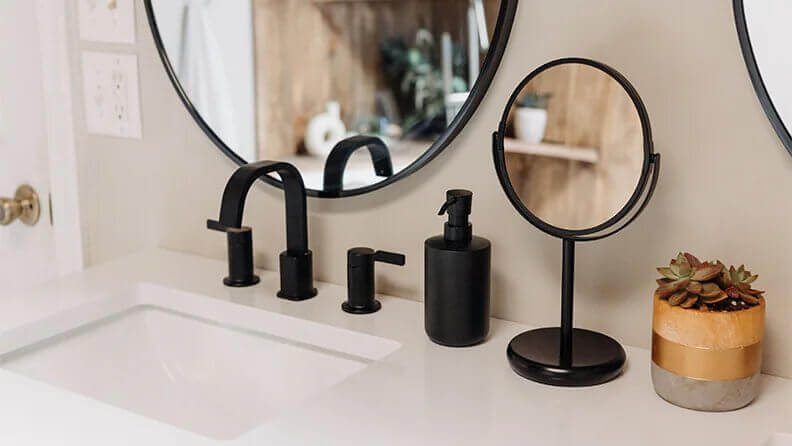
Solid Surface
Solid surface materials have become increasingly popular in recent years, made from a mixture of crushed minerals and resin. This material has a matte finish and offers excellent stain, scratch, and wear resistance. A notable advantage of solid surface materials is that they can be repaired—minor scratches can be sanded out. While solid surface materials are not cheap, they are more economical compared to marble.
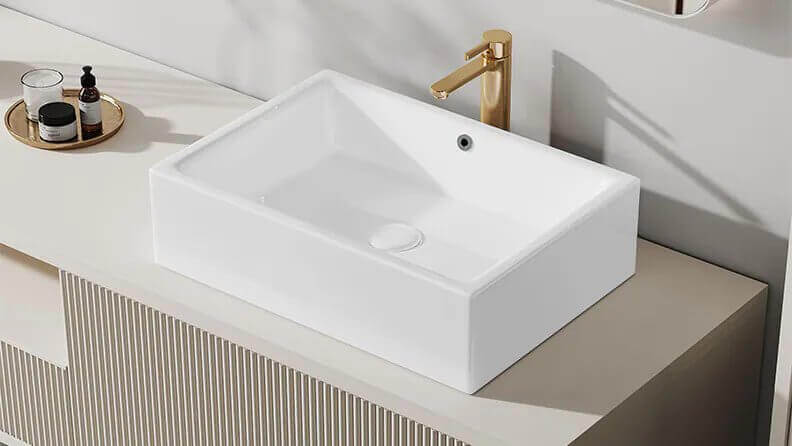
Ceramic
Ceramic is currently the most common and cost-effective material for bathroom vanity countertops and sinks. It is resistant to wear and scratches, and its smooth surface makes it very easy to clean. However, the reliability of ceramic is relatively low, especially when subjected to impact, as it may crack. Once the glaze is damaged, the surrounding area can quickly discolor, affecting the overall appearance.
Recommended Materials for Bathroom Vanity Faucets
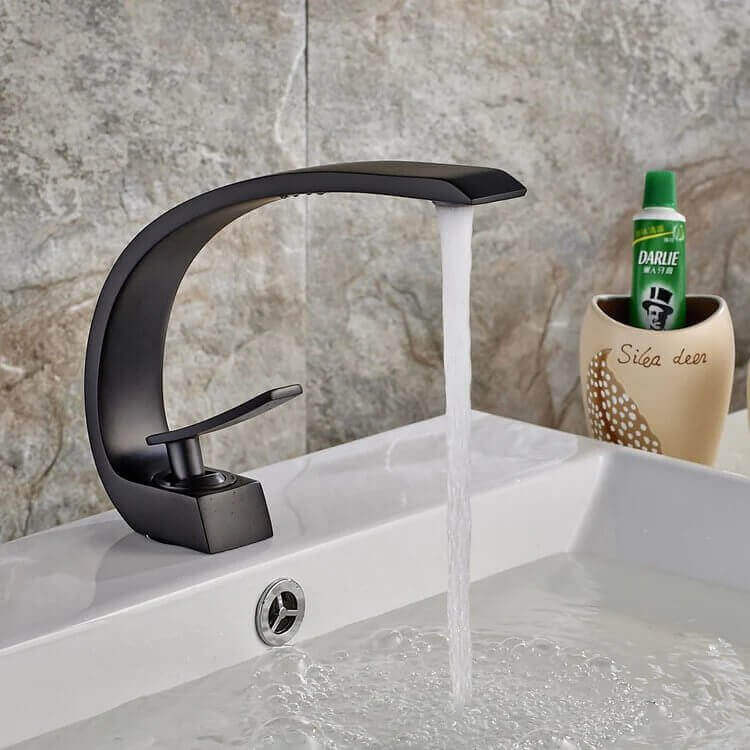
Brass
Brass is a sturdy and durable material commonly used in high-end faucets due to its ease of processing and molding. Brass faucets not only look more luxurious but also have antibacterial properties, ensuring the hygiene and safety of household water. They also have a longer service life. Although brass faucets are relatively expensive, this cost is worth it considering the investment in your entire bathroom vanity.
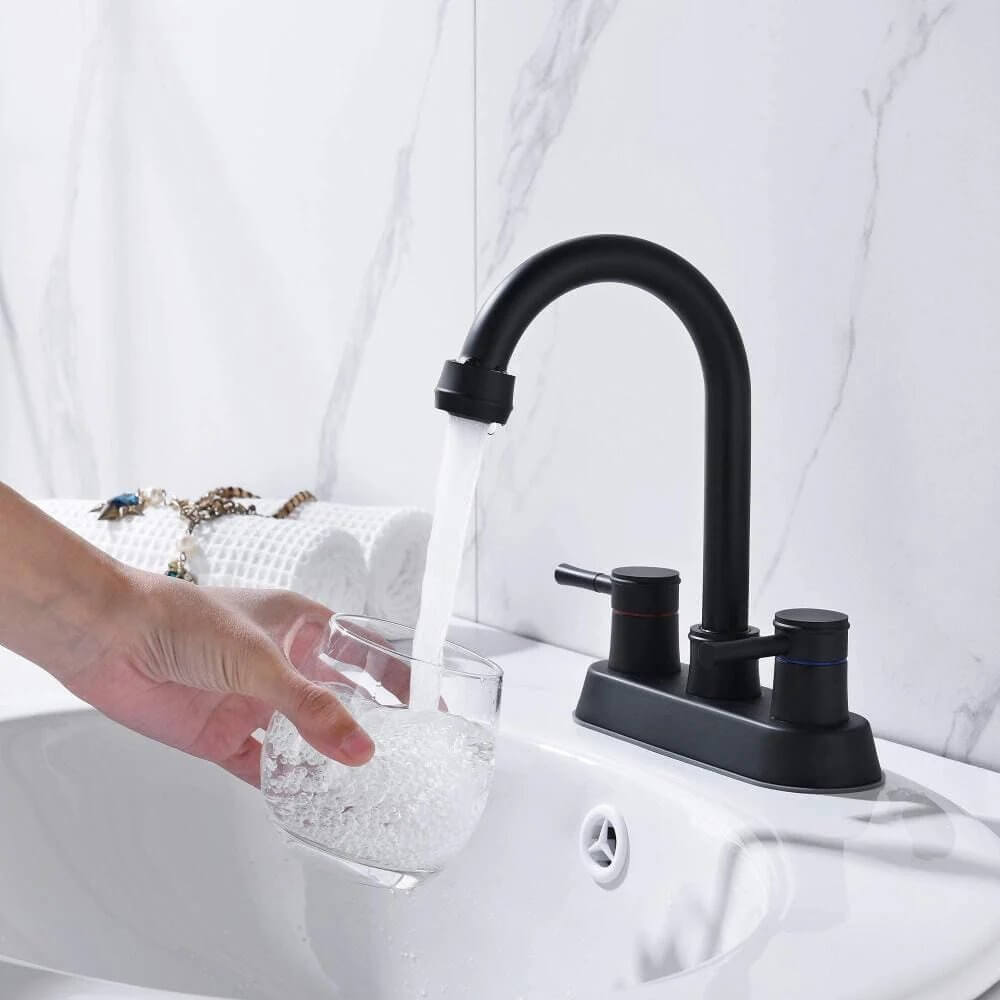
Stainless Steel
Stainless steel is the most commonly used material for household faucets. Its biggest advantage is its strong corrosion resistance and the fact that it does not release harmful substances like lead, making it excellent in terms of safety. However, stainless steel faucets may appear relatively ordinary and lack the luxury appeal, making them less suitable for users seeking a high-end bathroom design.
Ending
The bathroom vanity is the centerpiece of the entire bathroom, and its aesthetic appeal directly affects the mood of anyone entering the space. Since the bathroom environment is humid and frequently exposed to chemicals, choosing the right materials is crucial. The materials introduced in this article are all high-quality recommendations, though there are other materials available on the market for you to explore. If you find it too overwhelming to choose the right material among so many options, feel free to contact our customer service team. We will provide you with the best recommendations from a professional perspective, saving you time and ensuring your bathroom design is as perfect as possible.
More Ideas
-

How to Install a Vessel Sink in 4 Easy Steps
If the dimensional look and artistic appeal of a vessel sink have already captured your attention, then now is the perfect time to upgrade your bathroom with one. Whether you...
-

Vessel Sink Pros and Cons
In bathroom remodeling, the sink is one of the most frequently used fixtures, and your choice directly affects daily convenience and the overall look of the space. In recent years,...
-

How to Choose the Right Height for a Vessel Sink Vanity
In today’s home design, where aesthetics and spatial layering are highly valued, vessel sink vanities have become a popular choice. Their raised bowl design adds vertical depth and visual interest...
-

Toilet Paper Shortage: Fact or Fiction? How to Prepare
Still haunted by memories of the 2020 toilet paper panic, many Americans are now asking: Is it time to start stockpiling again? A wave of concern has been spreading across...
-

What Do Gallstones in the Toilet Look Like?
Have you ever had this experience — after using the bathroom, you glance into the toilet and notice some strange-looking objects floating or sinking at the bottom? They might vary...
-

How to Properly Measure a Toilet Seat?
Over time, a toilet seat can show its age—whether it’s from everyday wear, cracks caused by repeated slamming, or simply low-quality materials that don’t hold up. Whatever the reason, once...






